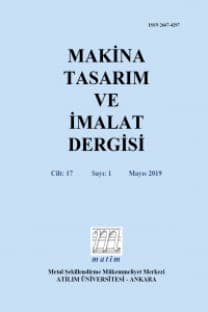İşleme Merkezlerinin Dinamik Analizi ve Süreçte Kararlılık Yeni Bir Analitik Modelin Uygulamaları
Talaşlı imalatta karşılaşılan ve
süreç verimliliğini olumsuz yönde etkileyen kendinden kaynaklı titreşimler
(tırlama), kullanılan sistemin kararlılık diyagramları sayesinde
engellenebilmektedir. Kararlılık diyagramlarını oluşturmak için ana gereksinim,
sistemin kesici takım ucundaki frekans tepki fonksiyonu (FTF) şeklindeki sistem
dinamiği bilgisidir. Bu çalışmada, iş mili — takım tutucu — takım sisteminin
dinamik modellemesi ve takım ucu FTF 'sinin elde edilmesi için geliştirilen bir
analitik modelin özeti ve uygulamaları sunulmuştur. Modelin teorik
uygulamaları; rulman ve bağlantı dinamik özellikleri ile bazı tasarım ve
uygulama parametrelerinin takım ucu FTF'si ve dolayısıyla sistem kararlılığına
etkilerinin analizini içermektedir. Sunulan model sayesinde bir sistemin
kararlılık diyagramının oldukça hassas bir şekilde elde edilebileceği ve elde
edilen diyagramın istenilen şekilde değiştirilerek kararlılığın
artırılabileceği, tezgâh üzerinde deneysel olarak gösterilmiştir.
Anahtar Kelimeler:
Tırlama, Tezgâh Dinamiği, Yüksek Performanslı Rulman ve Bağlantı Dinamiği, İş Mili Tasarımı
___
- 1. S.A. Tobias, W. Fishwick, The chatter of lathe tools under orthogonal cutting conditions, Tran-sactions of ASME 80 (1958) 1079-1088.
- 2. S.A. Tobias, Machine Tool Vibration, Blackie and Sons Ltd, 1965.
- 3. J. Tlusty, M. Polacek, The stability of machine tools against self-excited vibrations in machin-ing, Proceedings of the ASME International Re-search in Production Engineering, Pittsburgh, USA, (1963) 465-474.
- 4. H. Merrit, Theory of self-excited machine tool chatter, Transactions of ASME Journal of Engi-neering for Industry 87 (1965) 447-454.
- 5. F. Koenisberger, J. Tlusty, Machine Tool Struc-tures — yol. I: Stability Against Chatter, Per-gamon Press, Englewood Cliffs, NJ, 1967.
- 6. J. Tlıısty. E Ismail. Basic nonlinearity in ma-chining chatter, Annals of the CIRP 30 (1981) 21-25.
- 7. J. Tlıısty. Dynamies of high-speed Transactions of ASME Jounıal of Engineering for Industry (1986) 108 (2) 59-67.
- 8. S. Smitk J. Tlusty. Efficient simulation pro-granıs for chatter in milling. Annals of the CIRP 42 (1)(1993)463-466.
- 9. I. Minis, T. Yanushevsk-y, R. Tembo, R. Hock-en. Anaylsis ot linear and nonlinear chatter in milling. Annals of the C1RP 39 (1990) 459-462.
- 10. I. Minis, T. Yanushevsky, A new theorelical approach for prediction of machine tool chatter in milling, ASME Joumal of Engineering for Industry 115 (1993)1-8.
- 11. Y. Allintas. E. Ihıdak. Analytical prediction of stability lobes in milli%) Annals of the CIRP 44 (1995) 357-362.
- 12. E. Budak. Y. Allintas. Analytical prediction of chatter stabiliW in milling — pan I: general for-mulatiom pan Il: application to common milling systems, Transactions of ASME, Joumal of Dy-munic Systems, Measumment. and Control. 120 (1998)22-36.
- 13. J. Tlusıy, ManuDeturing Procmsses and Equip-ment. Pranice Halt Upper Saddle River. 2000.
- 14. T. Schmitt, R. Donaldson, Predicting high-speed machiningdynamics by substructure analysis, Annals of the CIRP 49 (1)(2000)303. 308.
- 15. T. Schmitt. M. Davies, M. Kennedy. Tool point frequency response prediction for high-speed machining by RCSA, Joumal of Manufacturing Science and Engineering 123 (2001) 700-707.
- 16. T. Schmitt. M. Davics, K. Medieus, J. Synder. Improving high-specd machining matertal r•-moval mtes by rapid dynamic analysis, Armals of the CIRP 50 (1) (2001) 263-268.
- 17. T. Schmitt, T. Burns. Receptance ooupling for high-speed machining dynaınies prediction, Proceedings of the 21st International Modal Analysis Conference. Febtumy 3-6, 2003. Kit,- simmee. Fl. (CD'de).
- 18. S.S. Park, Y. Altintas. M. Movahhedy, Re-ceptance coupling for end milis, International Immo! of Machine Tools and Manufacture 43 (2003)889-896.
- 19. E.B. Kivanc, E. Budak, Structural modeling of end milis for form error ond stability analysis. International Joumal of Machine Tools and Manufacture 44 (2004)1151-1161.
- 20. G.S. Duncan, T. Schmitt. An improved RCSA model for bol point frequeney response predie-tion, Proceedings of the 23rd International Moda! Analysis Conference, January 30 — Feb-ruary 3, 2005, Orlando, FL (CD'de).
- 21. A. Ertürk, H.N. Özgüven, E. Budak, Analytical modeling of spindle-tool dynaınics on machine tools using Timoshenko beam model and re-ceptance coupling for the prediction of tool point FRF, International Journal of Machine Tools and Manufacture, 2006, in press.
- 22. (doi:10.1016/j .ijmachtools .2006.03 .032)
- 23. A. Ertürk, H.N. Özgüven, E. Budak, Effect analy sis of bearing and interface dynamics on tool point FRF for chatter stability in machine tools by using a new analytical model for spin-dle-tool asseınblies, International Journal of Machine Tools and Manufacture, 2006, in press.
- 24. (doi:10.10 1 6/j .ijmachtools .2006.03 .001 )
- 25. A. Ertürk, E. Budak, H.N. Özgüven, Selection of design and operational parameters in spindle-holder-tool assemblies for maximum chatter stability by using a new analytical model, Pro-ceedings of the 2nd CIRP Conference on High Performance Cutting, 12-13 June 2006, Van-couver, BC Canada (CD'de).
- 26. W. Weaver, S.P. Timoshenko, D.H. Young, Vi-bration Problems in Engineering, Wiley Inter-science, NY, 1990.
- 27. H.N. Özgüven, Structural modifications using frequency response functions, Mechanical Sys-tems and Signal Processing 4 (1) (1990) 53-63.
- 28. A. Ertürk, E. Budak, H.N. Özgüven, İşleıne merkezlerinde iş mili — takım tutucu — takım sis-teminin dinamik modellenmesi, 12. Ulusal Ma-kine Teorisi Sempozyumu Bildiriler Kitabı, cilt 1, 15-26, 9-11 Haziran 2005, Kayseri.
- 29. A. Ertürk, işleme merkezlerinde iş mili — takım sisteminin dinamik modellemesi, Yüksek Lisans Tezi, Makina Mühendisliği Bölümü, Orta Doğu Teknik Üniversitesi, Mayıs 2006, Ankara.
- 30. N. Arakere, T. Schınitz, C. Cheng, Rotor dy-naınic response of a high-speed machine tool spindle, Proceedings of the 23rd International Modal Analysis Conference, January 30 — Feb-ruary 3, 2005, Orlando, FL (CD'de).
- 31. Y. Cao, Y. Altintas, A general method for the modeling of spindle-bearing systems, ASME Journal of Mechanical Design 126 (2004) 1089- 1104.
- ISSN: 1302-9487
- Başlangıç: 1986
- Yayıncı: Makina Tasarım ve İmalat Derneği
Sayıdaki Diğer Makaleler
İşleme Merkezlerinin Dinamik Analizi ve Süreçte Kararlılık Yeni Bir Analitik Modelin Uygulamaları
Alper ERTÜRK, H. Nevzat ÖZGÜVEN, Erhan BUDAK
Beklemeli Hareket Yapan Uzaysal Mekanizmaların Tasarımı
Volkan PARLAKTAŞ, Eres SÖYLEMEZ
Alaaddin TOKTAŞ, Mustafa TAYANÇ
